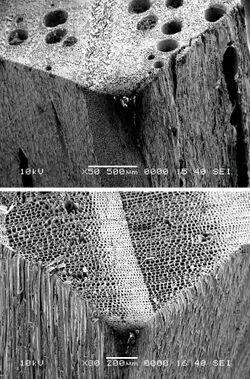Engineering:Softwood
thumb|Scots Pine, a typical and well-known softwood
Softwood is wood from gymnosperm trees such as conifers. The term is opposed to hardwood, which is the wood from angiosperm trees. The main differences between hardwoods and softwoods is that the structure of hardwoods lack resin canals, whereas softwoods lack pores[clarification needed] (though not all softwoods have resin canals).[1]
Characteristics

Softwood is wood from gymnosperm trees such as pines and spruces. Softwoods are not necessarily softer than hardwoods.[2] The hardest hardwoods are much harder than any softwood,[citation needed] but in both groups there is enormous variation with the range of wood hardness of the two groups overlapping. For example, balsa wood, which is a hardwood, is softer than most softwoods, whereas the longleaf pine, Douglas fir, and yew softwoods are much harder than several hardwoods.[citation needed]
Softwoods are generally most used by the construction industry and are also used to produce paper pulp, and card products.[3] In many of these applications, there is a constant need for density and thickness monitoring and gamma-ray sensors have shown good performance in this case.[4]
Certain species of softwood are more resistant to insect attack from woodworm, as certain insects prefer damp hardwood.
Examples of softwood trees and uses
- Douglas fir - joinery, doors and heavy construction
- Eastern white pine - furniture
- European spruce - used throughout construction, panelling and cladding
- Larch - cladding and boats
- Lodgepole pine - roofing, flooring and in making chipboard and particle board[5]
- Monterey pine
- Parana pine - stair treads and joinery
- Scots pine - construction industry, mostly for interior work
- Sitka spruce - [6]
- Southern yellow pine - joinery, flooring and decking
- Western hemlock - doors, joinery and furniture
- Western red cedar (or red cedar) - furniture, decking, cladding, and roof shingles
- Yew - interior and exterior furniture e.g. chairs, gate posts and wood turning
Applications
Softwood is the source of about 80% of the world's production of timber,[7] with traditional centres of production being the Baltic region (including Scandinavia and Russia ), North America and China. Softwood is typically used in construction as structural carcassing timber, as well as finishing timber.
See also
- List of woods
- United States – Canada softwood lumber dispute
- Hardwood
- Janka hardness test
- Brinell scale
References
- ↑ Bond, Brian; Hamner, Peter, Wood Identification for Hardwood and Softwood Species Native to Tennessee
- ↑ Buckley, Michael (2005). "A basic guide to softwoods and hardwoods". worldhardwoods.com. http://www.worldhardwoods.com/files/articles_basicguide.pdf.
- ↑ Ryan, V. (2012). "REVISION CARDS - SOFTWOODS". technologystudent.com. http://www.technologystudent.com/joints/softwoods1.html.
- ↑ Beigzadeh, A.M. (2019). "Design, modelling and construction of a continuous nuclear gauge for measuring the fluid levels". Measurement 138: 157–161. doi:10.1016/j.measurement.2019.02.017.
- ↑ "Things we make from softwood trees". forestry.gov.uk. 11 July 2017. https://www.forestry.gov.uk/forestry/infd-52jc96.
- ↑ Harding, T. (1988). "British Softwoods:Properties and Uses". forestry.gov.uk. https://www.forestry.gov.uk/PDF/FCBU077.pdf/$FILE/FCBU077.pdf.
- ↑ United Nations Forest Products Annual Market Review 2007-2008, p. 46, at Google Books
 |

